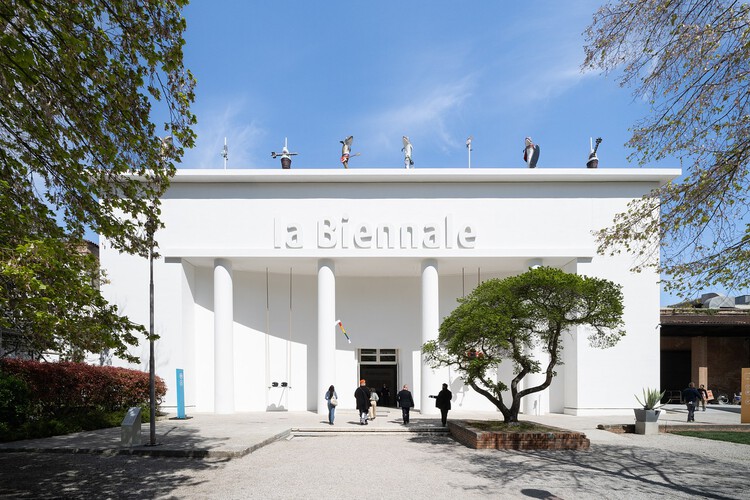 Image courtesy of La Biennale di Venezia
Image courtesy of La Biennale di Venezia
Share
Share
Or
https://www.archdaily.com/1030943/nothing-is-lost-everything-transforms-the-reusable-future-of-the-biennials-structures
At the end of each edition of the Architecture Biennale, far from the public eye, tons of exhibition materials are transported across Venice in handcarts and boats. Only a small portion of these materials is reused. The main obstacles are the limited storage space in Venice and the high logistical costs—recurring challenges for circular architecture. As a result, most of the waste ends up in landfills or nearby recycling centers. But this scenario is beginning to change. In response to growing environmental concerns, architects are developing strategies to make reuse more viable. These efforts go beyond architectural and construction decisions—they also involve logistics and international trade.
For decades, the Biennale’s pavilions and exhibitions were conceived as short-lived showcases focused on visual impact, bold gestures, and material innovation. However, in the face of the global climate crisis and increasing awareness of ecological limits, this approach is being re-evaluated. The 2025 edition marks a turning point, with sustainability taking the lead in both the curatorial and technical agendas. For the first time, the Biennale aims to achieve carbon-neutral certification, in line with ISO 14068 standards, and several pavilions are being designed with disassembly, reuse, and low environmental impact in mind.
The idea of reuse, however, is not entirely new. Long before it became a response to the climate crisis, the reuse of pavilions and other temporary structures was practiced for economic, practical, or symbolic reasons. A classic example is the Barcelona Pavilion, designed by Mies van der Rohe for the 1929 International Exposition. Built with high-end materials such as steel, marble, and travertine, it was dismantled after the event. Its parts returned to Germany: the metal structure was sold as scrap, and the stones were reused in other buildings.
Related Article Afterlife of Pavilions: Exploring Reuse in Temporary Architecture 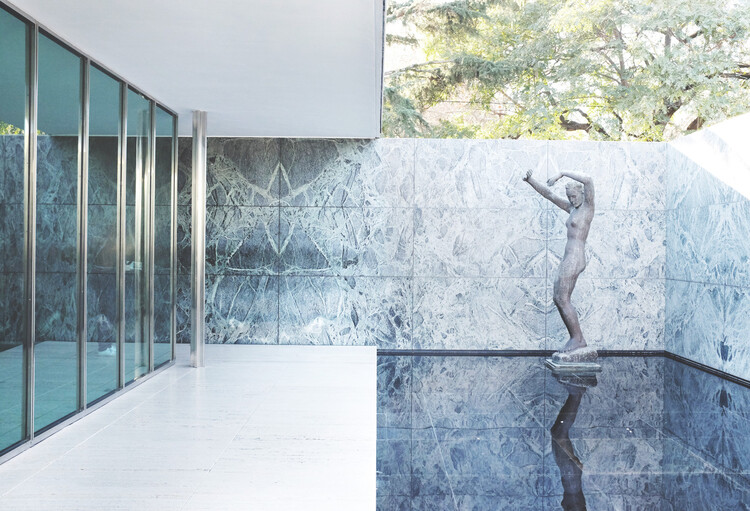 AD Classics: Barcelona Pavilion / Mies van der Rohe © Gili Merin
AD Classics: Barcelona Pavilion / Mies van der Rohe © Gili Merin
At the end of each edition of the Architecture Biennale, far from the public eye, tons of exhibition materials are transported across Venice in handcarts and boats. Only a small portion of these materials is reused. The main obstacles are the limited storage space in Venice and the high logistical costs—recurring challenges for circular architecture. As a result, most of the waste ends up in landfills or nearby recycling centers. But this scenario is beginning to change. In response to growing environmental concerns, architects are developing strategies to make reuse more viable. These efforts go beyond architectural and construction decisions—they also involve logistics and international trade.
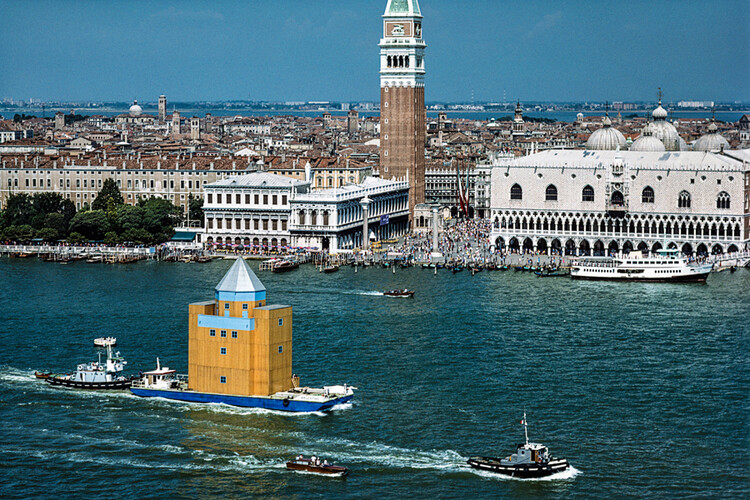 Bodybuilding, Aldo Rossi, Il Teatro del Mondo, Venice 1979. Image by Antonio Martinelli
Bodybuilding, Aldo Rossi, Il Teatro del Mondo, Venice 1979. Image by Antonio Martinelli
For decades, the Biennale’s pavilions and exhibitions were conceived as short-lived showcases focused on visual impact, bold gestures, and material innovation. However, in the face of the global climate crisis and increasing awareness of ecological limits, this approach is being re-evaluated. The 2025 edition marks a turning point, with sustainability taking the lead in both the curatorial and technical agendas. For the first time, the Biennale aims to achieve carbon-neutral certification, in line with ISO 14068 standards, and several pavilions are being designed with disassembly, reuse, and low environmental impact in mind.
The idea of reuse, however, is not entirely new. Long before it became a response to the climate crisis, the reuse of pavilions and other temporary structures was practiced for economic, practical, or symbolic reasons. A classic example is the Barcelona Pavilion, designed by Mies van der Rohe for the 1929 International Exposition. Built with high-end materials such as steel, marble, and travertine, it was dismantled after the event. Its parts returned to Germany: the metal structure was sold as scrap, and the stones were reused in other buildings.
At the end of each edition of the Architecture Biennale, far from the public eye, tons of exhibition materials are transported across Venice in handcarts and boats. Only a small portion of these materials is reused. The main obstacles are the limited storage space in Venice and the high logistical costs—recurring challenges for circular architecture. As a result, most of the waste ends up in landfills or nearby recycling centers. But this scenario is beginning to change. In response to growing environmental concerns, architects are developing strategies to make reuse more viable. These efforts go beyond architectural and construction decisions—they also involve logistics and international trade.
For decades, the Biennale’s pavilions and exhibitions were conceived as short-lived showcases focused on visual impact, bold gestures, and material innovation. However, in the face of the global climate crisis and increasing awareness of ecological limits, this approach is being re-evaluated. The 2025 edition marks a turning point, with sustainability taking the lead in both the curatorial and technical agendas. For the first time, the Biennale aims to achieve carbon-neutral certification, in line with ISO 14068 standards, and several pavilions are being designed with disassembly, reuse, and low environmental impact in mind.
The idea of reuse, however, is not entirely new. Long before it became a response to the climate crisis, the reuse of pavilions and other temporary structures was practiced for economic, practical, or symbolic reasons. A classic example is the Barcelona Pavilion, designed by Mies van der Rohe for the 1929 International Exposition. Built with high-end materials such as steel, marble, and travertine, it was dismantled after the event. Its parts returned to Germany: the metal structure was sold as scrap, and the stones were reused in other buildings.
Even the Biennale’s own history features early examples of reuse. In the inaugural 1980 edition, Aldo Rossi’s iconic Teatro del Mondo stood out. After the exhibition, this imposing floating steel structure was transported to Dubrovnik, Croatia, where it remained anchored in the Adriatic Sea before eventually being dismantled. In today’s terms, its journey can be seen as an early case of “post-exhibition life.” Still, despite prompting discussions on the future of such installations, it didn’t establish a lasting model.
A Timeline of Transformation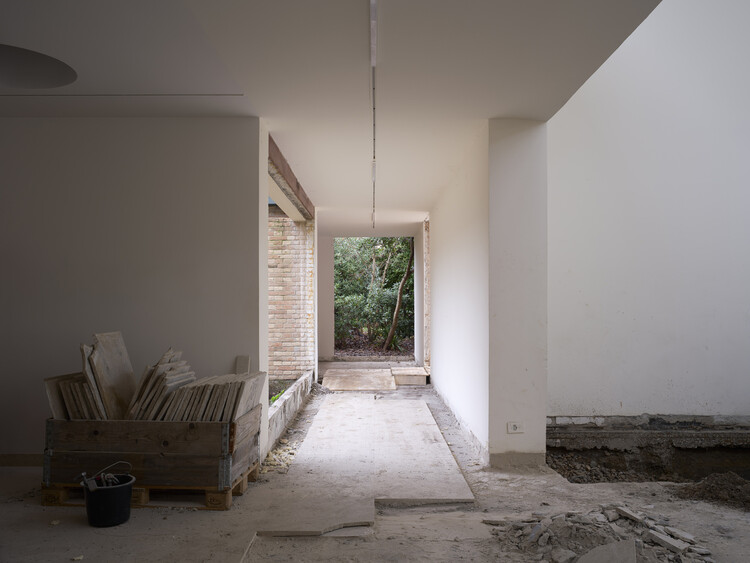 ‘Build of Site’ exhibition. Danish pavilion at the 19th Venice Architecture Biennale. Image © Hampus Berndtson
‘Build of Site’ exhibition. Danish pavilion at the 19th Venice Architecture Biennale. Image © Hampus Berndtson
With a few exceptions, the 1980s and 1990s editions of the Venice Biennale were dominated by grand architectural gestures. Pavilions like the UK’s, with Richard Rogers’s high-tech aesthetic, or the US’s, featuring Frank Gehry’s monumental installations, reinforced the idea of architecture as spectacle. The use of industrial and disposable materials was often embraced as part of that performance. Even in the 2000s, when curatorial approaches began to address relationships between space, territory, and society, the Biennale’s logistical model—build, then dismantle and discard—remained largely unchanged.
The Biennale’s shift toward sustainability and collective responsibility is often linked to the 2021 edition, themed ‘How Will We Live Together?’ Yet even in earlier editions, these concerns were subtly present, reflected in the exhibitions’ critical and provocative nature. A more concrete turning point came in 2023 with Germany’s Open for Maintenance Pavilion, which emphasized material reuse and circular economy principles.
Materials from nearly 40 national pavilions and exhibitions were saved from landfill and transported to the German Pavilion in a labor-intensive process. These salvaged materials became part of structural interventions in the pavilion. Throughout the 2023 edition, aided by a new digital database, the materials were cataloged and made available. Over six months, students and apprentices, working alongside local activist groups, reused the materials in a continuous series of workshops titled Maintenance 1:1, grounded in the principles of circular construction.
The New Pavilions: Designed for Disassembly, Circularity, and Regeneration
By 2025, the concern with sustainability and full life-cycle thinking had moved to the forefront of the Biennale. Today’s pavilions are conceived not merely as temporary constructions but as complete material cycles. Disassembly is no longer an afterthought—it is a fundamental part of the design process.
The Danish Pavilion, curated by Søren Pihlmann, was transformed into a fully operational construction site. Using pre-existing materials, the project offered visitors a transparent, educational experience, showing how architecture can be assembled, dismantled, and relocated with environmental care. This approach emphasized modularity and adaptability, proving that temporary structures don’t have to be discarded—they can be reintegrated into ongoing cycles of reuse and transformation.
The French Pavilion followed a similarly thoughtful approach. Its main element, a temporary construction site installation, was built with scaffolding, fabrics, and nets rented locally in Venice. The flooring consisted of modular panels on loan, while audiovisual, lighting, and safety equipment were also borrowed and set to be returned after the event.
Brazil’s contribution explored the intersection of ancestral knowledge and contemporary urban infrastructure. Built with CLT panels, stone, and steel cables, the installation was designed for easy disassembly and future reuse. The project emphasized the balance between lightness and stability, allowing the components to be either reassembled or recycled after the Biennale.
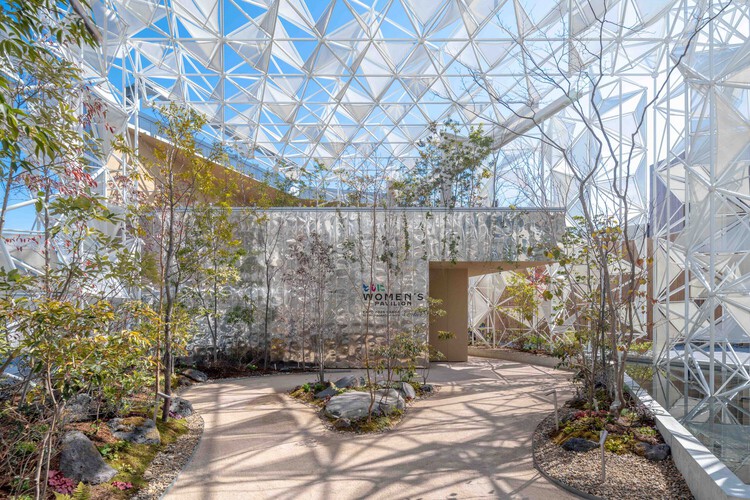 Women’s Pavilion at Expo 2025 Osaka in collaboration with Cartier / Yuko Nagayama & Associates © Nobutada OmoteArchitectural Strategies: Thinking in Reverse
Women’s Pavilion at Expo 2025 Osaka in collaboration with Cartier / Yuko Nagayama & Associates © Nobutada OmoteArchitectural Strategies: Thinking in Reverse
Taken together, these examples illustrate a key shift: a move toward reversible architecture. This shift represents a new paradigm in sustainability, one that goes beyond reducing environmental impact to embrace circularity and adaptability. Reversibility often means rejecting conventional construction methods like adhesives, welds, or permanent fasteners, and instead using mechanical joints and dry connections that allow components to be dismantled without damage—as with the CLT elements in Brazil’s Pavilion. Complementing this is the Design for Disassembly (DfD) philosophy, which calls for buildings to be designed so that their parts can be easily identified, separated, and reused—supported by clear documentation to make the process practical and efficient, as demonstrated in the German Pavilion of 2023.
Material choices also follow this logic, prioritizing regenerative raw materials that not only minimize environmental impact during extraction and processing, but can also return to natural cycles at the end of their life. Earth, certified wood, mycelium, and other organic composites are increasingly used in the Biennale’s temporary structures. In 2023, Belgium’s Pavilion used mycelium in a structure designed for disassembly and repurposing through the local initiative Re-Biennale. Founded by Venetian students and architects, Re-Biennale emerged in response to the massive waste generated by the Biennale, with the mission of repurposing discarded materials in collaborative urban regeneration projects.
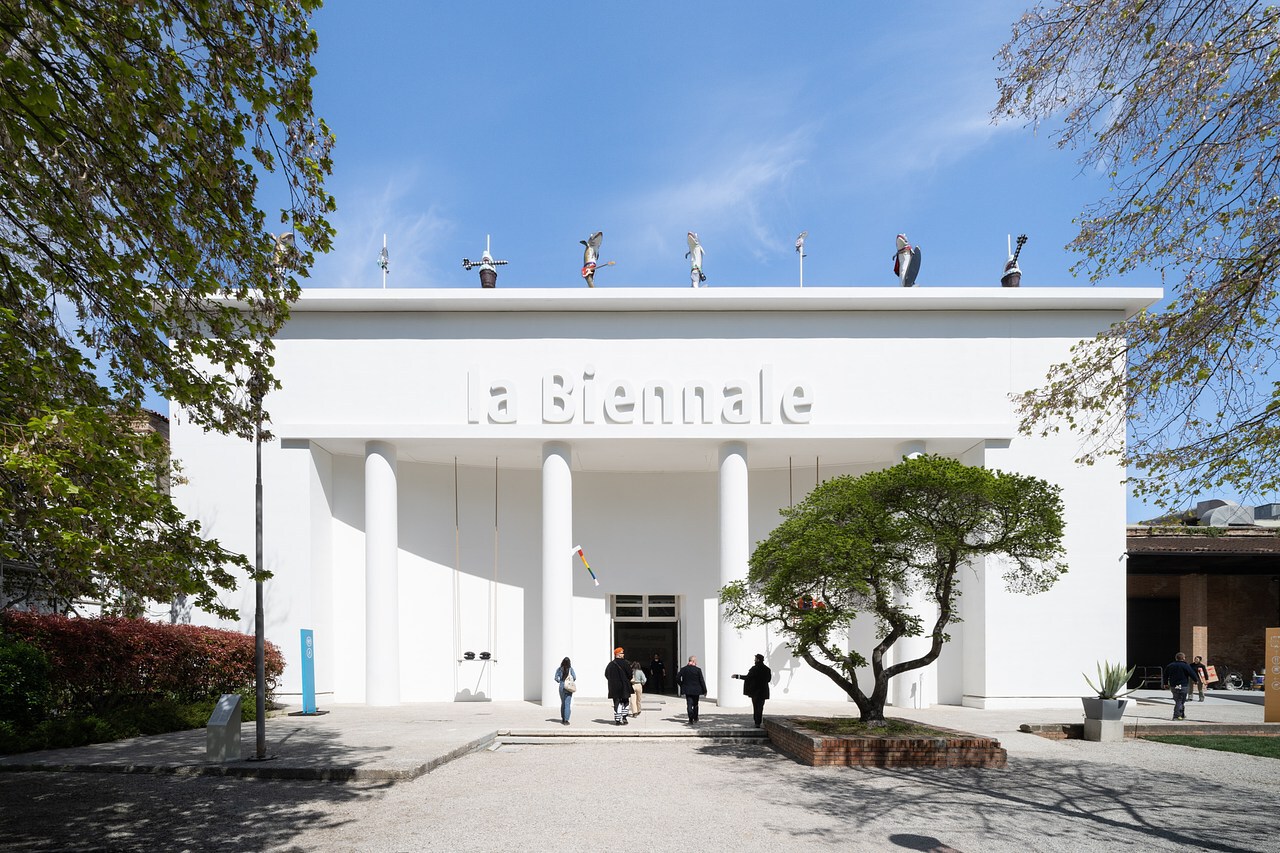




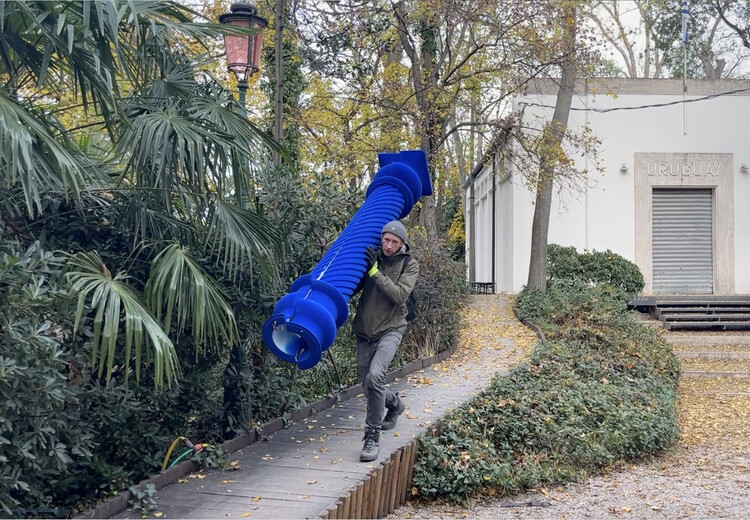 Spolia from the exhibition “Queendom” of the Israel Pavilion at the Biennale Arte 2022, December 2022. Image © ARCH+ SUMMACUMFEMMER BÜRO JULIANE GREB
Spolia from the exhibition “Queendom” of the Israel Pavilion at the Biennale Arte 2022, December 2022. Image © ARCH+ SUMMACUMFEMMER BÜRO JULIANE GREB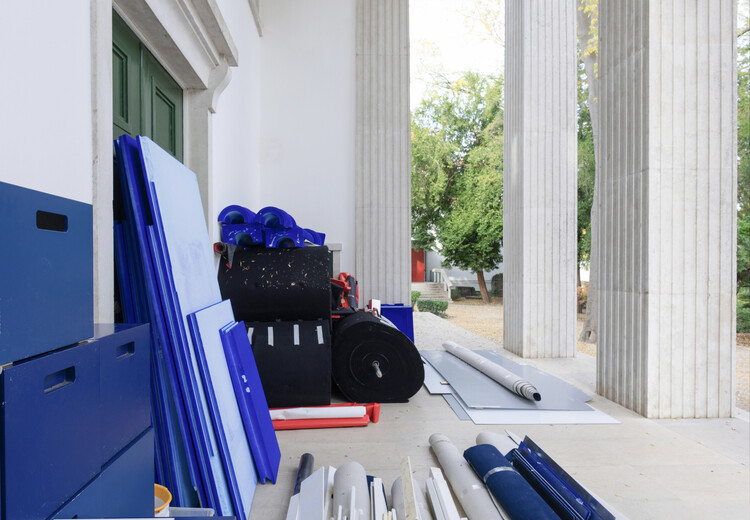 Fragments from the Biennale Arte 2022, temporarily stored at the entrance of the German Pavilion, December 2022. Image © ARCH+ SUMMACUMFEMMER BÜRO JULIANE GREB
Fragments from the Biennale Arte 2022, temporarily stored at the entrance of the German Pavilion, December 2022. Image © ARCH+ SUMMACUMFEMMER BÜRO JULIANE GREB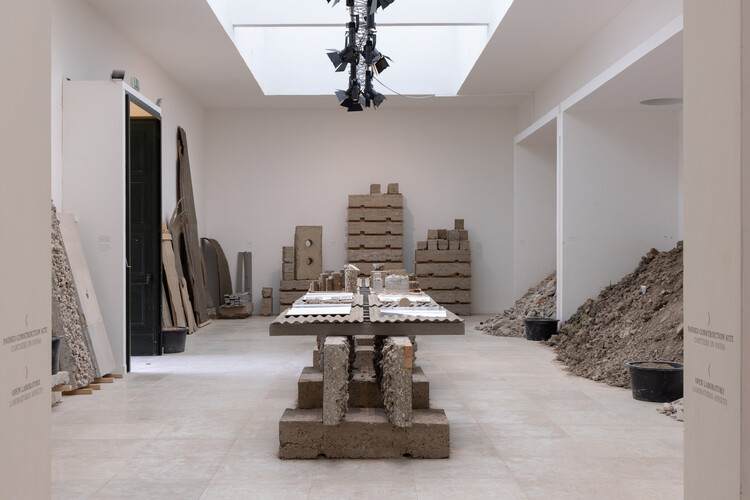 ‘Build of Site’ exhibition. Danish pavilion at the 19th Venice Architecture Biennale. Image © Hampus Berndtson
‘Build of Site’ exhibition. Danish pavilion at the 19th Venice Architecture Biennale. Image © Hampus Berndtson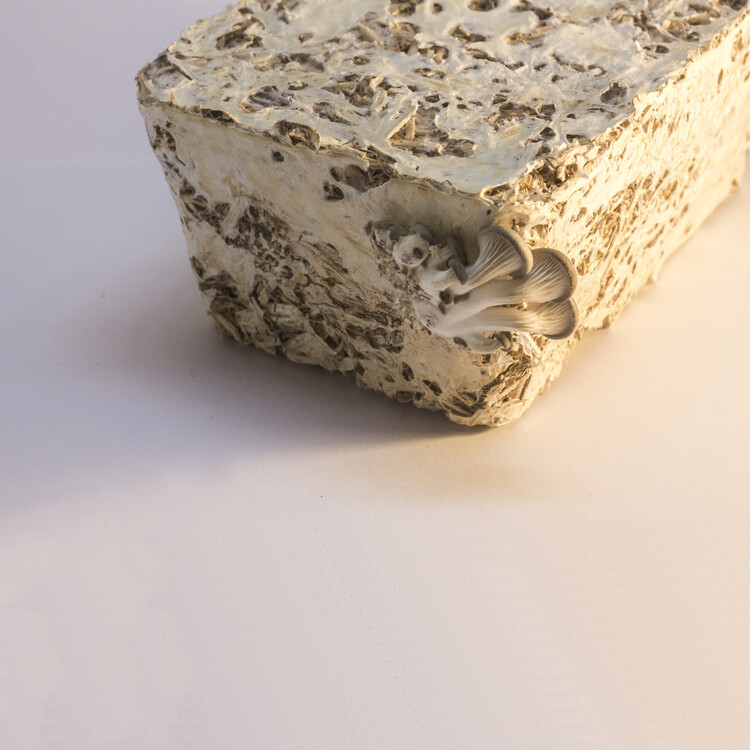 The Belgian Pavilion Investigates Relationship of Architects with Resources at the 2023 Venice Biennale. Image courtesy of Bento
The Belgian Pavilion Investigates Relationship of Architects with Resources at the 2023 Venice Biennale. Image courtesy of Bento